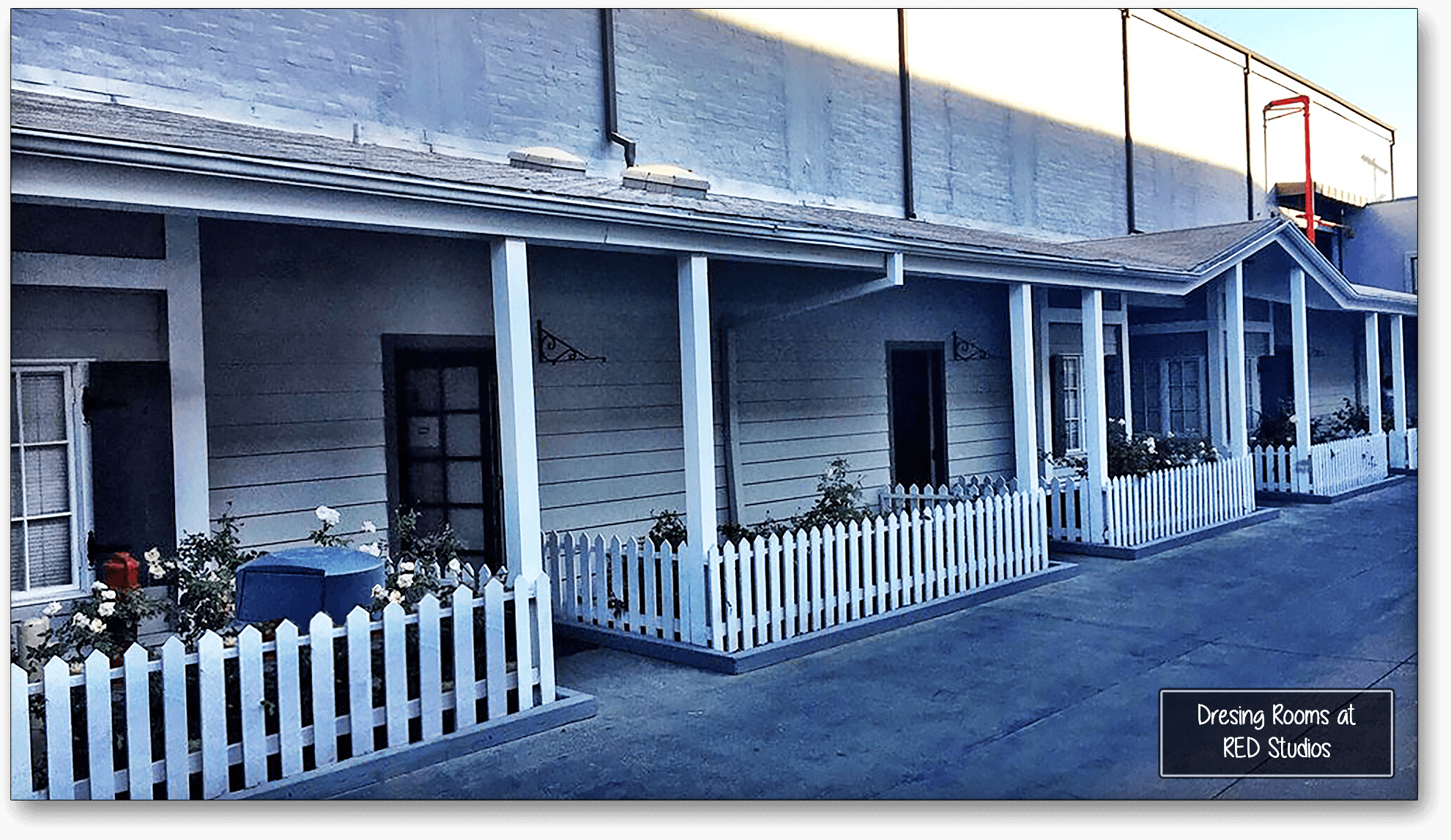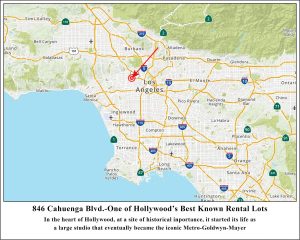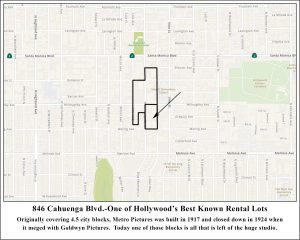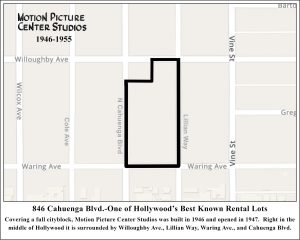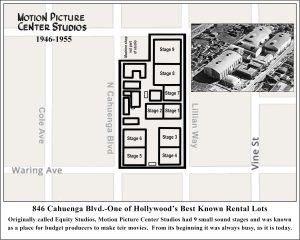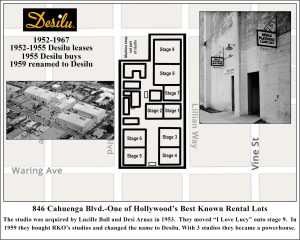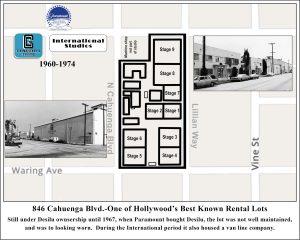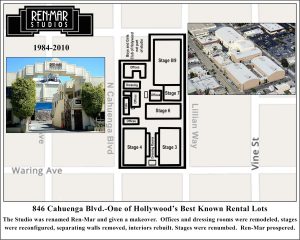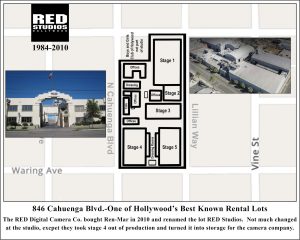846 N. Cahuenga Blvd.
Desilu Studio, Motion Picture Center, and Others
This one block, 5 stage studio is a part of legacy of the venerable MGM Studios
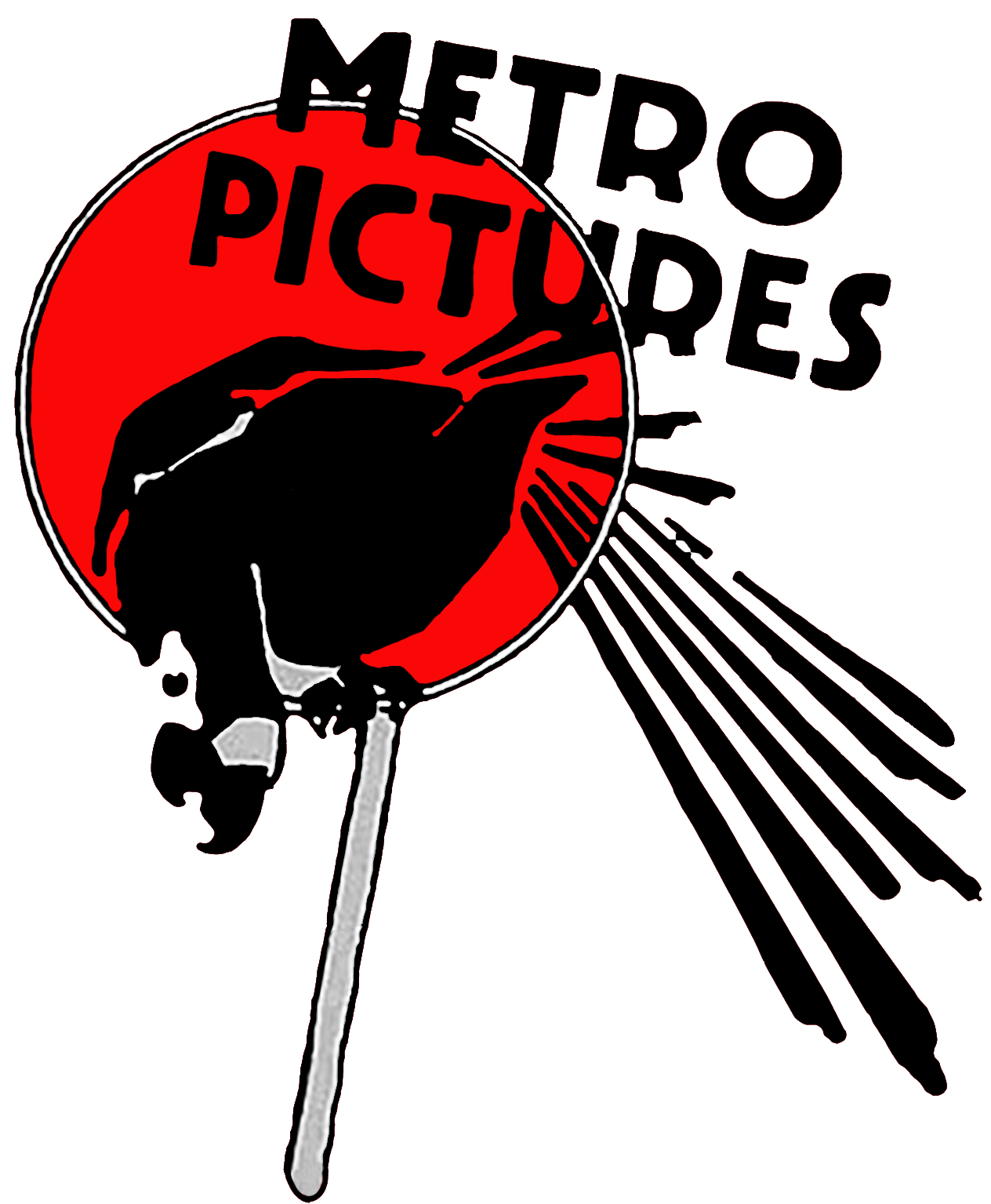
Metro Studios
810-846 N. Cahuenga Blvd.
This spot, this small studio on the block bound by Cahuenga and Lillian on the west and east, and Willoughby and Waring on the north and south. This is today, the lonely stepchild of what became the iconic monolithic Metro Goldwyn Studios of Culver City.
In 1924, the Metro and Goldwyn Companies merged. Metro's studio here, covering four and a half city blocks, was abruptly abandoned in favor of the much larger and more modern Goldwyn Studio in Culver City. Metro lay abandoned and derelict for 2 decades until lot 3, one of the two old backlots, was leased and a new studio built in its place. It still exists to this day as a very active rental studio, the home to a number of very popular films and shows.
click to enlarge
Related Pages:
Read More:

Equity Studios
810-846 N. Cahuenga Blvd.
1946-1947
In May 1946 two industry businessmen took out a long-term lease and began construction on the old Metro Studios lot 3 at Willoughby and Cahuenga, one of the old Metro backlots in the heart of Hollywood. Equity Studios, Inc. began building themselves a small one block studio comprised of 9 small sound stages. On January 10, 1947, they opened the doors for business offering stage and facilities rentals and distribution of films for independent producers. The studio was formed by George J. Schaefer and Jack Schwartz, long time industry executives.
Earlier in his career, Schaeffer was CEO of United Artists and president of RKO. He produced Citizen Kane and The Magnificient Ambersons for Orson Welles.

810-846 N. Cahuenga Blvd.
under this name:1947-1959
under this ownership 1947-1955
By May of 1947, the studio's name was changed to Motion Picture Center Studios and Schaeffer was out of the picture. replaced by Harry Thomas (former president of Producers Releasing) with Schwartz continuing as company VP. Over the years the officers of the studio would change on a regular basis.
Known as a studio friendly to low-budget producers, in 1948 managing partner Charles L. Glett, former general manager for David O. Selznick Studios, began a program completely unique and totally innovative in the industry. The resources of the studio were made available to television and telefilm producers on a profit-sharing basis. Fees and profits for the studio were deferred and recouped when a film or program went into distribution. Stage 7, one of the small stages, went through a reconstruction. A mezzanine was built around the upper part of the 45-foot high stage and transformed into production offices with rooms for writers, directors, editors, and projection. The floor of the stage was transformed into several small shooting stages. It operated, effectively, as a studio within a studio. Producers had free use of all the rest of the studio facilities including administration, accounting, lighting and grip, carpentry, props, electrical, scenic art, transportation, sound, and cameras. The departments and their personnel were at the disposal of the producers. Participating writers, actors, and directors were also on a profit-split basis if they were in agreement (with the permission of the unions).
Acknowledging the new reality that television was here to stay, by 1951 the Studio's new president, Jason Justman, turned half the studio's resources theatrical film production to small screen program production. A new unit of the studio was added: Motion Picture Television Center, which under separate management oversaw the television side of the studio's business. The new unit entered into a partnership with the Fort Lee Studios, one of Fort Lee's only remaining studios. They would handle East Coast production and sales handling mostly commercials.
Denying rumors that the studio was for sale, in 1952 Justman leased the entire lot to Lucy and Desi.
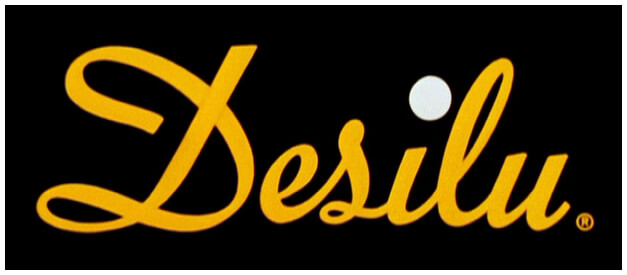
Desilu-Cahuenga Studios
846 N. Cahuenga Blvd.
leased from 1952-1955
owned 1955-1968
as Motion Picture Cente Studios 1952-1959
as Desilu-Cahuenga Studios 1955-1968
If there were a mid-century television icon, one could argue that it was Lucille Ball and, by extension, her husband Desi Arnaz. Famed for a couple of things: their classic I Love Lucy television show and pioneering the three-camera sitcom set up in front of a live audience.
After spending two seasons at the neighboring General Services Studio, Desilu first leased and bought this 9 stage studio moving the show here. They also began a vigorous program of television production, being the most prolific company of the era.
It could also be argued that Lucy and Desi were also famous for one more small thing: they owned or controlled more sound stages than any other "studio mogul" in the business for a period of a decade and a half. In 1955 Desilu add two more studio lots to their empire, buying out the RKO Gower St. and Culver City Studios, along with the RKO's Culver City backlot. The company headquarters was moved to the Gower lot. They owned 35 stages across 3 studios, including their original studio, Desilu-Cahuenga, right here at 846 N. Cahuenga Blvd.
Desilu produced more television than any other concern, at its peak producing 7+ hours a week of sitcoms plus a variety of hour-long dramas. I Love Lucy, Our Miss Brooks, The Danny Thomas Show, The Andy Griffith Show, Gomer Pyle, USMC, and many, many others including the original Star Trek series starring William Shatner and Leonard Nimoy.
Desi proved to be an astute business person and, after buying him out in the early 1960s, Lucy proved to be just as smart, making some savvy business and programming decisions.
In 1960 DeliLu Cahuenga was taken over by Paramount Television and in 1967 Lucille Ball sold the Desilu company to Paramount along with the two Hollywood lots. The Culver City studio was sold to a private concern. Lucy became very wealthy just from her business acumen.
Several more Names beginning in 1960
Paramount pictures, located just a couple of blocks away from Desilu, leased the lot to expand its television production, while Desilu also occupied Paramount's neighbor, the former RKO studio. By the late 1960s Lucille Ball, now the sole owner and, as it turned out, a master entertainment business manager, sold both lots to Paramount (and sole their Culver Ci9ty studio to a private concern).
Paramount was a short term owner as Cinema General bought and owned the studio from 1969-1974, then selling it to a moving and storage company, Rene and Marjorie Lambert of Rene Van and Storage, who used the studio partly as a rental studio and partly as a place to park their moving trucks and took over one of the big stages (today's Stage 4) as a storage facility.
In 1974 the Lamberts changed the studio's name to Ren-Mar Studios and made stage rental more of a priority, moving the van line off the lot while keeping Stage 4 as storage.
Ren-Mar Studios brought back they hey-day of television production for the small studio. They gave the lot a make-over, upgraded and remodeled the stages, and other studio facilities. By 2004 stage 4 was revamped and brought back into production as an audience rated stage, as were stage 8/9 and stage 5. It prospered hosting many television programs (primarily sitcoms) and providing stage space for many well-known films. The primary Ren-Mar tenant for many years was Witt-Thomas-Harris Productions who made Ren-Mar their company headquarters, producing many top television programs here including The Golden Girls, Blossom, and Empty Nest. Ren-Mar also famously provided stage space for the animated hit film Who Framed Roger Rabbit, turning the studio into Maroon Cartoons, Roger Rabbit's studio. Other films shot here included Pretty Persuasion, and the horror film The Relic, as well as the first season of the hit show Ally McBeal, the pilot for the John Larroquette Show. News Radio, Hillary Duff's Lizzy McGuire, and seasons 2-5 of Tony Shalhoub's series Monk. It was also the stage location for many music videos for Madonna, INXS, Michael Jackson, Ozzy Osbourne, Hilary Duff, and Britney Spears.
In 2010 the Lamberts sold The studio to Jim Jannard, the owner of RED Digital Camera and Oakly Company, who changed the name to RED Studios. The stage configurations were changed and stage 4 remained out of production, as storage for the digital camera side of the business.



















